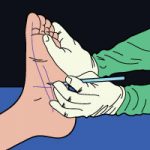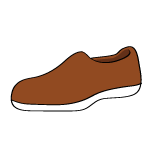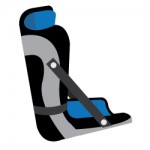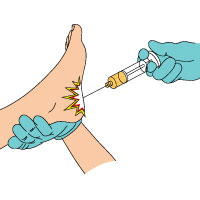Why You Want to Avoid Surgery
When it comes to any injury, surgery should always be a last resort. Non-invasive treatment methods are always preferred. Surgery is sometimes thought to be a “quick fix” that will get y ou back to your usual activities faster than the conservative method, but this simply isn’t true. Surgery comes with a variety of risks and complications and should be seriously considered before going through with it. In most cases of Plantar Fasciitis, surgery is not required. Your Plantar can heal the conservative way.
ou back to your usual activities faster than the conservative method, but this simply isn’t true. Surgery comes with a variety of risks and complications and should be seriously considered before going through with it. In most cases of Plantar Fasciitis, surgery is not required. Your Plantar can heal the conservative way.
Plantar Fasciitis surgery is not always successful either. Some patients who undergo Plantar Fascia Release are left with a loosened Plantar, which can lead to fallen arches, and a whole set of other problems that can arise from this condition. Cutting the Plantar is like cutting the string on a bow. It’s meant to be tight, and cutting it causes it to loosen. Altering the natural structure of the Plantar only leads to problems.
How to Avoid Surgery
Rest, Ice, Compression & Elevation
Resting your foot means not doing any activities that could cause further strain on the Plantar Fascia. This includes standing and walking for extensive periods. If you are a runner, you should take some time off from running to allow your Plantar to heal. Continuing with activities that stress the Plantar tissue will only make your Plantar Fasciitis worse.
should take some time off from running to allow your Plantar to heal. Continuing with activities that stress the Plantar tissue will only make your Plantar Fasciitis worse.
Applying ice and compression to your Plantar will help relieve your pain and swelling. This is the first step towards healing.
Elevating your foot will work to bring down any internal inflammation. This is inflammation you can’t see because it’s deep below the skin, in the soft tissue.
Use Crutches
Using crutches will keep the weight off your injured Plantar, helping you avoid further damage.
Avoid Cortisone Shots
Cortisone shots are intended to temporarily relieve pain and swelling, but they come with side effects and risks that could make your situation much worse. Studies have shown that continued use of cortisone shots can cause bone death, skin discoloration, nerve damage and even complete rupture of the Plantar Fascia. If your Plantar tissue becomes completely ruptured, the only way to heal the tear is through surgery.
Wear Proper Shoes
Wearing shoes with proper support can go a long way towards improving your condition. Make sure your shoes are not worn out, as this could mean they are not giving your feet the support they need. Your shoes should also be a good fit, which means they should not be too tight or too loose. Avoid wearing high heels, as these strain the Plantar Fascia. Consider wearing a pair of slippers around the house for extra support.
Watch Your Weight
Since being overweight causes more strain on the Plantar Fascia, keeping your weight in check can help lessen your symptoms.
Avoid Night Splints
Contrary to popular belief, night splints will not help heal your Plantar Fasciitis. Night splints actually cause more harm than good. They put the Plantar in an unnatural, stretched position that interferes with healing. This can lead to the development of gait issues and flat feet.
Avoid Insoles and Orthotics
Insoles and orthotics (also called arch supports) will only cause further damage to your Plantar. If your shoes need extra support, apply it to the heel and ball areas, not the arch. Your weight is balanced by the heel and ball of your foot, not your Plantar. Pressure applied to and pushing up on your Plantar will lead to further pain and injury. It is not designed to withstand this kind of pressure.
Avoid Painkillers During Physical Activity
Painkillers should only be used during times of rest. Painkillers mask the pain signal, making you unaware of further damage you could be doing during physical activity. This is dangerous and can lead to complete rupture of the Plantar if you’re not careful.

